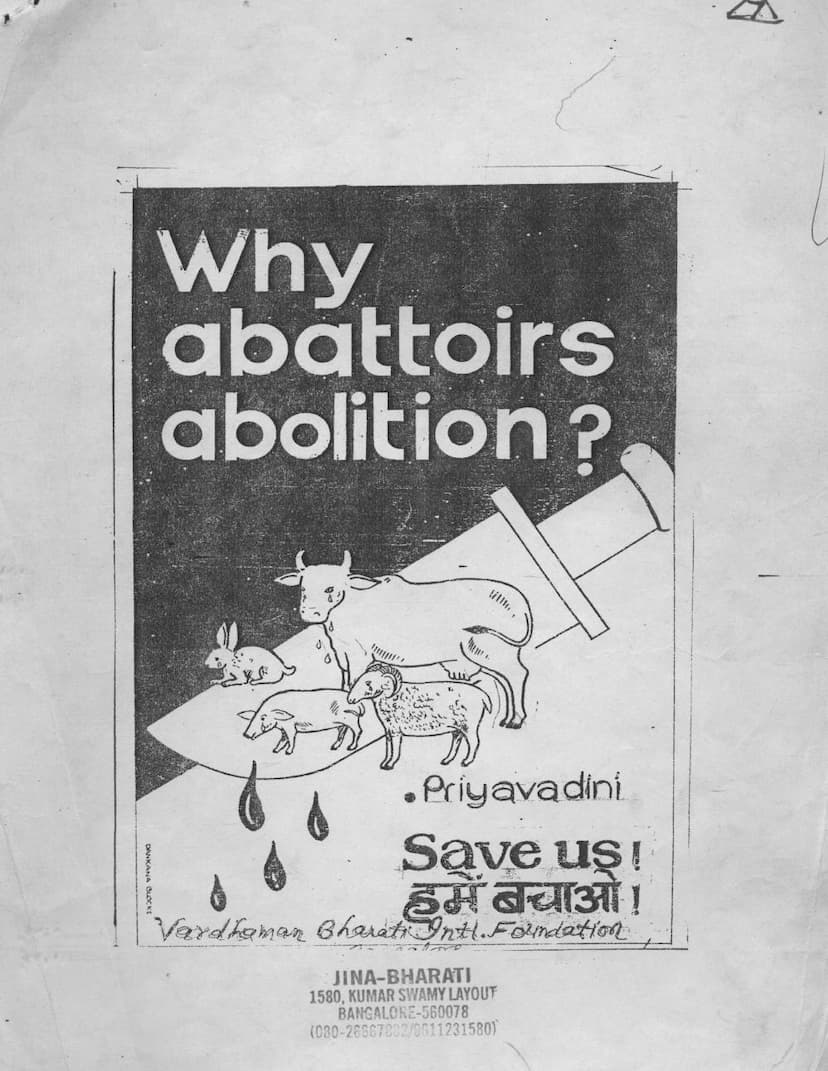Why Abattoirs Abolition
Added to library: September 2, 2025

Summary
Here's a comprehensive summary of the Jain text "Why Abattoirs Abolition" by Pratap J Tolia, based on the provided pages:
Core Argument: The book is a passionate and forceful argument for the abolition of abattoirs (slaughterhouses) and the universal adoption of vegetarianism. It frames this as a critical issue for the future of humanity, linking animal welfare to environmental stability, economic prosperity, and spiritual well-being.
Historical and Spiritual Foundation:
- Jain Philosophy: The text draws heavily from Jain principles, particularly the concept of Ahimsa (non-violence) and the teachings of the Tirthankaras, starting with Adinatha Rishabhadeva. Rishabhadeva is presented as the founder of human civilization, advocating for a life of compassion, vegetarianism, and respect for all living beings.
- Ancient Civilizations: The book traces the lineage of non-violence and vegetarianism from ancient times, highlighting Rishabhadeva's teachings on agriculture and the importance of cows and bulls. It emphasizes that primitive human diets were primarily vegetarian.
- Key Figures: The narrative highlights the contributions of figures like Neminatha (who renounced his wedding upon hearing the cries of animals destined for slaughter), Parshwanatha, Mahaveera, and Buddha, all of whom championed compassion and non-violence.
- Modern Advocates: The book places significant importance on Srimad Rajachandra, the spiritual guide of Mahatma Gandhi, and Gandhi himself, as pivotal figures in modern India who advocated for non-violence and vegetarianism. It laments that despite their efforts, the culture of abattoirs and meat consumption has proliferated.
Critique of Abattoirs and Meat Consumption:
- Ethical and Moral Objections: Abattoirs are portrayed as inherently cruel and violent institutions that betray the very essence of humanity and its spiritual heritage. The author questions the moral justification of killing innocent animals, especially when alternative food sources exist.
- Environmental Impact: Modern abattoirs are identified as major sources of pollution, contributing to the degradation of the environment. The immense water consumption in these industries is also highlighted as a serious concern, especially in the context of water scarcity.
- Economic Arguments: The text challenges the economic justifications for abattoirs. It argues that the foundation of India's economy lies in agriculture and cattle wealth, which are destroyed by slaughtering. The author contends that meat is an expensive food, and the focus on meat export undermines the country's agrarian economy and rural livelihoods.
- Health Concerns: The book asserts that vegetarian food is inherently healthier and that meat consumption is scientifically proven to cause diseases and pollute the body. It contrasts this with the growing trend of vegetarianism in the West.
- Societal and Cultural Degradation: The proliferation of abattoirs and meat consumption is linked to a broader societal decline, including increased violence, corruption, and divisions. The author poses the alarming question of why natural calamities like earthquakes occur in proximity to large slaughterhouses, citing scientific studies linking animal suffering to geological disturbances.
The Role of Abattoirs in India:
- Historical Context: The book points to the British colonial era as a period when India's forests, villages, and cattle wealth were systematically weakened, with the establishment of slaughterhouses playing a role. It criticizes the post-independence policies of Indian governments for continuing and expanding these practices, often influenced by Western models and for the sake of foreign exchange.
- Specific Examples: The proposed mechanized abattoir at Kacharakanahalli near Bengaluru is used as a case study to illustrate the arguments against abattoirs. The author also criticizes the Deonar Abattoir in Mumbai as a symbol of national shame.
- Economic Motivation: The primary driver for the growth of abattoirs is seen as economic gain through meat export, often at the expense of the nation's true wealth – its agriculture and animal population.
Call to Action and Hope:
- Youth Empowerment: The book places significant hope in the younger generation to awaken and take a stand against the "industry of violence." It urges them to think deeply, question existing practices, and champion the cause of non-violence and vegetarianism.
- Political and Social Responsibility: The author directly addresses politicians and meat consumers, urging them to abolish abattoirs, ban meat exports, and adopt vegetarianism.
- Revisiting Core Values: The text calls for a re-evaluation of India's cultural and spiritual heritage, emphasizing that true progress lies in embracing compassion, non-violence, and harmonious coexistence with all life forms.
- The Two Religions: The conclusion suggests that humanity faces a choice between two fundamental paths: one driven by violence and the other by compassion and non-violence.
Overall Tone and Style:
The book is written with strong conviction and a sense of urgency. It uses evocative language, historical accounts, and appeals to both reason and emotion to convey its message. The author is deeply passionate about the subject and expresses dismay at the continuation of practices he views as detrimental to humanity and the planet. The inclusion of quotes from historical figures and scholars reinforces the arguments presented.